Re-Check Those RejectsThe past year has been the biggest black-hole of fossil collecting since I started this hobby. I could usually count on Aurora to quench my fossil thirst but with my last two slot days being cancelled due to weather, it seemed that any opportunity to come up would get sucked into oblivion. Last week I finally found a couple of hours where I could get out. Despite my “love-dislike” (hate would be too strong a word) relationship with GMR, I decided it would be my easiest destination. I love GMR because there is potential to make some really nice finds, as evident in fellow BRFer’s recent posts. I dislike GMR because nice teeth are few and far between. My average is usually 1 case worthy tooth for every 3 or so trips.
I parked at Greensprings Park and stopped at one of my usual scanning spots. After about 5 minutes I found a decent mako lying in about 6 inches of water; it was about 2 inches, somewhat worn, but atypically complete for GMR. I continued up past areas that I know had been scoured by fellow collectors until I came to an unfamiliar stretch. The gravel looked good. Loaded with bone, but devoid of teeth; even partial ones. I quickly got the feeling that I hadn’t been the only sheriff in town. I gave myself three more screen loads before I moved and on the second screen it came, a really nice great white. It was a lower tooth, about 2" with really nice color, very nice blade and a slightly worn but complete root - definitely case worthy. I made the decision to continue in that spot for the remainder of the day. After about two hours with no other decent teeth, my reject pile was at a pretty respectable size. Past experience has taught me to regularly graze through my reject piles as some of my best finds manage to escape detection in the screen. One item at the base of the pile caught my eye. It was about two inches long, had an oval cross-section and was heavily striated. It reminded me of a partial mastodon tooth that I had found at GMR last year; that piece had similar, though much less pronounced striations. This however was significantly different outside of the striations and I really didn’t have much of an idea what it was other than it appeared to be mammalian.
Once home I was able to clean it off and get a better look at it. The one thing that really stood out was that the striations were not only on the sides. The bottom of the piece, which is quite worn, also displays striations perpendicular to the ones running on the outside. It appeared to be “hatched”. Tusks are composed of hair that weave an intertwining pattern similar to a basket. When the ivory breaks, the pattern is very evident at the cross-section. This appeared to be part of a tusk. I emailed the pictures to a friend for a professional opinion and while it couldn’t be determined whether it was mastodon or mammoth, he confirmed that it was indeed a piece of tusk. I think I’ll put this trip in the “Love” column.
|
Location
| Green Mill Run, North Carolina, USA |
| ID | 3429 |
| Member | xiphodan |
| Date Added | 8/1/2009 |
| | |
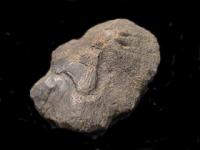 |
| Ray Scute with some enamel still intact. |
|
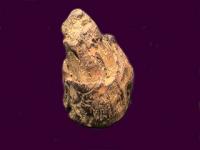 |
| The core of a mastodon or mammoth tusk. |
|
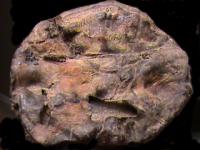 |
| Tusk Cross-section |
|
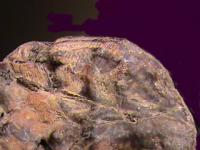 |
| Cross-section with faint hatching visable. |
|
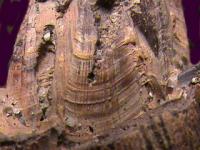 |
| Close-up of inner core surface. |
|
|